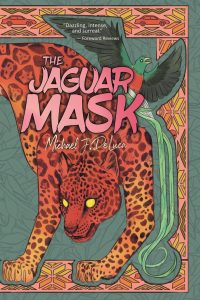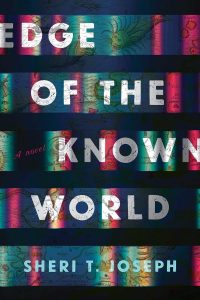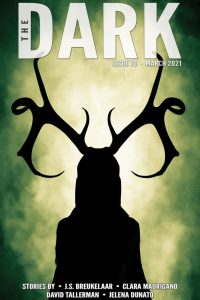Jake Casella Brookins Reviews The Jaguar Mask by Michael J. DeLuca
 The Jaguar Mask, Michael J. DeLuca (Stelliform 978-1-77809-260-2, 348pp, $19.00, tp) August 2024. Cover by Julia Louise Pereira.
The Jaguar Mask, Michael J. DeLuca (Stelliform 978-1-77809-260-2, 348pp, $19.00, tp) August 2024. Cover by Julia Louise Pereira.
I was quite charmed by Michael J. DeLuca’s novella Night Roll, a solarpunk-adjacent fantasy set in Detroit. In his debut novel, The Jaguar Mask, DeLuca takes up a different kind of magic, but a similar kind of realism: a story of individuals and communities resisting oppression, on wounded but still generative land. Richly detailed and character-driven, The Jaguar Mask throws together surreal imagery, noirish political intrigue, and pointed commentary on the role of art to weave a story of self-discovery and resistance.
Mostly set in Guatemala City, but with excursions to other locations in the country, the novel takes place in the long shadow of Guatemala’s US-backed coup and the following decades of civil war, genocide of Indigenous peoples, and environmental degradation. Our two protagonists, Felipe K’icab and Cristina Ramos, are brought together by a brutal act of violence: the assassination of a foreign dignitary that catches Cristina’s mother in the crossfire, while political unrest and protests ratchet up the tension. Felipe, a cab driver whose friends and roommates are activists, finds himself dragooned into helping a corrupt former cop who’s investigating the murder, while Cristina, an artist, is propelled by her mother’s death into intense political and artistic discoveries.
Felipe, it should be mentioned, is a jaguar, who blends in with humans with the aid of a series of magical masks. Cristina immediately sees him as he is; all her life, she’s seen otherworldly but truthful visions, and woven them into her art.
Neither Felipe nor Cristina understand much, initially, about their magical natures, but DeLuca does a fascinating job of weaving that aspect into a story that’s just as complex and fantastical on more quotidian levels. When the plot does begin to shape up, it has a distinctly noir flavor. El Bufo, the disgraced investigator who pulls Felipe into the byzantine case, could have been a more classic noir protagonist in a slightly different novel: an antihero who’s morally gray at best, complete with a tragic backstory. Here, though, the narrative focus on Felipe and Cristina lets us see the way that the investigation is itself a source of violence and corruption, official and otherwise.
True to that noir sensibility, the novel does an excellent job of painting various parts of the city; DeLuca has a flair for depicting the variety and vibrancy of urban settings with a kind of hallucinatory richness that matches the novel’s animistic currents. Felipe drives Cristina to a building that’s described
like a Uaxactun temple times ten the color of overripe apricot flesh…Iridescent buses waited, glittering and flexing gills, impatient for the rivers of roads. Official taxis like glossy-shelled beetles, green and white, buzzed past out of the overwhelming sun, hovered in the thin band of the building’s shade, then buzzed away again.
Elsewhere, “Bent trees born from seeds sewn by the conquerors raised arms scarred wit the wounds of nails, the scars painted over in white, the paint splitting to reveal the scars.” Scenes and settings here have their own characters, are their own characters, in ways that layer nicely with the complexity of the human action.
The Jaguar Mask has an expansive feeling for geography, for land. Cristina’s journeys take her through the countryside and to smaller towns, and these excursions give a broader sense of the historical forces that are coming to a flashpoint in the main setting of Guatemala City: the oppression and persistence of the K’iche’ and other Mayan peoples, the injuries and poisons that industrial extraction is leaving in the land, and the wellspring of protest and syncretic religion that still runs deep. Traveling to and from the city, attempting to deal with her own grief and that of her family, Cristina finds herself increasingly sensitive to her own visions and powers. This comes to a head at her mother’s funeral, where she collapses after seeing angels or demons, “the specter of the past coming out of the future to signify the absolute stoppage of control.”
Cristina’s supernatural abilities are anchored in, or channeled by, her art; one of the more potent themes in The Jaguar Mask is the tension between art that sells easily – art that’s expected, that’s comforting, that reinforces the viewers’ preconceived notions – and art that challenges. Cristina has been making do with the former, but her real gift is to create paintings and sketches that are deeply discomfiting, that confront and bewilder people, that forces them see both the unsettling reality around them and the revolutionary power within them. It’s not a particularly subtle point, but a welcome and relevant one.
That power, and the pain of awakening to it, is really the core of the novel: Felipe beginning to embrace his nature, Cristina beginning to understand what she can do, and both of them discovering that they are not alone. It’s an impressive trick to wed these supernatural elements to the extremely realistic story of protests and police violence, of colonial legacies and justice still being fought for, without feeling like the fantastic elements are tacked on or overshadowing those realities. The Jaguar Mask’s magic and shapeshifters aren’t really “fantasy” in the way we generally use the genre term: They’re visions of real power in the people and the land.
Jake Casella Brookins is from the Pennsylvania Appalachians, and spent a fantastic amount of time in the woods. He studied biology, before switching over to philosophy & literature, at Mansfield University. He’s been a specialty coffee professional since 2006. He’s worn a lot of coffee hats. He worked in Upstate New York and Ontario for about 8 years. He’s been in Chicago since 2013; prior to the pandemic, he worked for Intelligentsia Coffee in the Loop. Starting in 2021, he’s been selling books at a local indie bookstore. He lives with his wife, Alison, and their dogs Tiptree & Jo, in Logan Square.
This review and more like it in the July 2024 issue of Locus.
 While you are here, please take a moment to support Locus with a one-time or recurring donation. We rely on reader donations to keep the magazine and site going, and would like to keep the site paywall free, but WE NEED YOUR FINANCIAL SUPPORT to continue quality coverage of the science fiction and fantasy field.
While you are here, please take a moment to support Locus with a one-time or recurring donation. We rely on reader donations to keep the magazine and site going, and would like to keep the site paywall free, but WE NEED YOUR FINANCIAL SUPPORT to continue quality coverage of the science fiction and fantasy field.
©Locus Magazine. Copyrighted material may not be republished without permission of LSFF.







